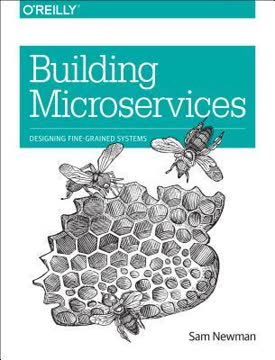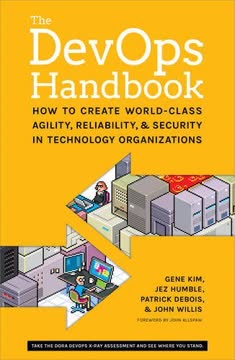Key Takeaways
1. Microservices: A Paradigm Shift in Software Architecture
The basic concept of a microservice is simple: it's a small application that does one thing only, and does that one thing well.
Microservices revolutionize software development. They break down monolithic applications into smaller, independent services, each responsible for a specific function. This architectural approach offers numerous benefits:
- Increased developer productivity and velocity
- Improved scalability and flexibility
- Easier adoption of new technologies
- Reduced technical debt
However, microservices also introduce new challenges:
- Increased operational complexity
- Potential for organizational silos
- Greater need for standardization and coordination
The transition from monoliths to microservices requires careful planning and a company-wide commitment to restructuring both the software architecture and the organizational structure.
2. The Four-Layer Model of Microservice Ecosystems
Microservices do not live in isolation. The environment in which microservices are built, are run, and interact is where they live.
Understanding the microservice ecosystem is crucial. The four-layer model provides a comprehensive framework for conceptualizing and managing microservice architectures:
- Hardware Layer: Physical servers, operating systems, and resource management
- Communication Layer: Network, DNS, service discovery, and load balancing
- Application Platform Layer: Development tools, deployment pipelines, and monitoring
- Microservice Layer: The actual microservices and their configurations
Each layer plays a vital role in the overall ecosystem:
- Lower layers provide the foundation and infrastructure
- Upper layers focus on service-specific functionality and business logic
- Clear separation of concerns allows for better management and scalability
Effective microservice architecture requires careful consideration and optimization of all four layers to ensure smooth operation and seamless interaction between services.
3. Production-Readiness: The Key to Microservice Standardization
A production-ready application or service is one that can be trusted to serve production traffic.
Production-readiness ensures microservice reliability. To achieve this, microservices must adhere to eight key principles:
- Stability
- Reliability
- Scalability
- Fault tolerance
- Catastrophe-preparedness
- Performance
- Monitoring
- Documentation
These principles work together to:
- Increase overall system availability
- Reduce the risk of outages and failures
- Improve developer productivity and confidence
Implementing production-readiness standards requires:
- Organizational buy-in at all levels
- Clear communication of expectations and requirements
- Regular audits and reviews to ensure compliance
- Continuous improvement and adaptation as the ecosystem evolves
4. Stability and Reliability: Cornerstones of Microservice Architecture
A stable microservice is one for which development, deployment, the adoption of new technologies, and the decommissioning or deprecation of other services do not give rise to instability across the larger microservice ecosystem.
Stability and reliability form the foundation of trust. To build stable and reliable microservices, focus on:
- Standardized development cycle
- Comprehensive deployment pipeline (staging, canary, production)
- Dependency management and failure mitigation
- Stable routing and discovery mechanisms
- Careful deprecation and decommissioning procedures
Key practices for ensuring stability and reliability:
- Implement thorough code testing (unit, integration, end-to-end)
- Use automated build and release processes
- Employ defensive caching and fallback mechanisms for dependencies
- Regularly review and update service architecture
- Maintain clear communication channels between teams
By prioritizing stability and reliability, organizations can create a robust microservice ecosystem that can withstand the challenges of rapid development and changing requirements.
5. Scalability and Performance: Designing for Growth and Efficiency
To ensure that our microservices are scalable and performant, we need to require several things of each microservice.
Scalability and performance drive efficiency. To build scalable and performant microservices:
- Understand qualitative and quantitative growth scales
- Use hardware resources efficiently
- Identify and address resource bottlenecks
- Implement automated capacity planning
- Ensure dependencies can scale with your service
- Design for efficient task handling and processing
Key considerations for scalability and performance:
- Choose appropriate programming languages and frameworks
- Implement horizontal scaling capabilities
- Optimize database design and usage
- Monitor and adjust for changing traffic patterns
- Regularly perform load testing and performance tuning
By focusing on scalability and performance from the outset, organizations can create microservices that can gracefully handle increased demand and maintain high levels of efficiency as they grow.
6. Fault Tolerance and Catastrophe-Preparedness: Embracing Failure
Microservices will fail, they will fail often, and any potential failure scenario can and will happen at some point within the microservice's lifetime.
Prepare for failure to ensure success. Building fault-tolerant and catastrophe-prepared microservices involves:
- Identifying and eliminating single points of failure
- Documenting all possible failure scenarios
- Implementing comprehensive resiliency testing
- Automating failure detection and remediation
- Establishing clear incident response procedures
Essential practices for fault tolerance:
- Conduct regular architecture reviews to identify vulnerabilities
- Implement circuit breakers and fallback mechanisms
- Perform chaos testing to simulate real-world failures
- Maintain up-to-date runbooks for incident response
- Foster a blameless culture that encourages learning from failures
By embracing the reality of failure and preparing for it systematically, organizations can create robust microservices that can withstand unexpected challenges and maintain high availability.
7. Monitoring: The Pulse of Your Microservices
The majority of outages in a microservice ecosystem are caused by bad deployments. The second most common cause of outages is the lack of proper monitoring.
Effective monitoring is crucial for microservice health. To implement production-ready monitoring:
- Identify and track key metrics at all levels (host, infrastructure, microservice)
- Implement comprehensive logging
- Create clear, informative dashboards
- Set up actionable alerting with appropriate thresholds
- Establish sustainable on-call rotations
Best practices for microservice monitoring:
- Log all relevant information without compromising security or performance
- Design dashboards that are easy to interpret at a glance
- Ensure all alerts are actionable and linked to runbooks
- Regularly review and update monitoring strategies
- Foster a culture of shared responsibility for service health
By implementing robust monitoring practices, organizations can detect and resolve issues quickly, maintaining high levels of microservice availability and performance.
8. Documentation and Understanding: The Unsung Heroes of Microservice Success
Always give an onion.
Documentation and understanding drive organizational alignment. To ensure comprehensive documentation and understanding:
- Maintain centralized, up-to-date documentation for all microservices
- Include key elements: description, architecture diagram, contact info, onboarding guide, API details, and runbooks
- Conduct regular architecture reviews
- Perform production-readiness audits
- Create and maintain production-readiness roadmaps
- Automate production-readiness checks where possible
Strategies for improving documentation and understanding:
- Make documentation updates part of the development workflow
- Use clear, jargon-free language accessible to all stakeholders
- Implement a FAQ section to address common questions
- Conduct regular knowledge-sharing sessions across teams
- Tie production-readiness to organizational OKRs and planning cycles
By prioritizing documentation and understanding, organizations can reduce technical debt, improve cross-team collaboration, and ensure the long-term success of their microservice ecosystem.
Last updated:
FAQ
What's "Production-Ready Microservices" by Susan J. Fowler about?
- Focus on Microservices: The book provides a comprehensive guide on building and maintaining microservices that are ready for production environments.
- Standardization Across Organizations: It emphasizes the importance of standardizing systems across an engineering organization to ensure reliability and efficiency.
- Real-World Application: The content is based on the author's experience at Uber, where she led a production-readiness initiative for microservices.
- Comprehensive Framework: It offers a detailed framework for achieving production-readiness, covering aspects like stability, reliability, scalability, and more.
Why should I read "Production-Ready Microservices"?
- Expert Insights: Gain insights from Susan J. Fowler, who has firsthand experience in transforming Uber's microservices.
- Practical Guidance: The book provides actionable steps and checklists to help engineers implement production-ready standards.
- Organizational Impact: Learn how to drive high standards across teams, improving overall system reliability and performance.
- Future-Proofing Skills: Understanding microservices is crucial for modern software development, and this book equips you with the necessary skills.
What are the key takeaways of "Production-Ready Microservices"?
- Eight Principles: The book outlines eight principles for production-readiness: stability, reliability, scalability, fault tolerance, catastrophe-preparedness, performance, monitoring, and documentation.
- Standardization is Key: Standardizing microservices across an organization is essential for maintaining high availability and reliability.
- Comprehensive Framework: It provides a detailed framework for evaluating and improving microservices, including checklists and roadmaps.
- Organizational Buy-In: Successful implementation requires buy-in from all levels of an organization, from developers to executives.
How does Susan J. Fowler define "production-ready" in microservices?
- Trustworthy Services: A production-ready service is one that can be trusted to serve production traffic reliably.
- Quantifiable Standards: It must meet quantifiable standards across eight key principles, ensuring high availability.
- Comprehensive Testing: The service should undergo thorough testing, including code, load, and chaos testing.
- Continuous Monitoring: Proper logging, dashboards, and alerting are essential to maintain production-readiness.
What are the eight production-readiness principles in "Production-Ready Microservices"?
- Stability: Ensures that changes do not introduce instability across the ecosystem.
- Reliability: Builds trust by ensuring services perform as expected under various conditions.
- Scalability: Prepares services to handle growth in traffic and tasks efficiently.
- Fault Tolerance: Ensures services can withstand and recover from failures and catastrophes.
How does "Production-Ready Microservices" suggest handling dependencies?
- Identify and Document: Know and document all dependencies, including their SLAs and potential failure points.
- Mitigation Strategies: Implement backups, alternatives, fallbacks, or caching to handle dependency failures.
- Communication: Maintain open communication with dependency teams to prepare for changes and potential issues.
- Defensive Caching: Use caching to protect your service from dependency failures, ensuring continued availability.
What is the role of monitoring in "Production-Ready Microservices"?
- Key Metrics: Identify and monitor key metrics at the host, infrastructure, and microservice levels.
- Logging: Implement comprehensive logging to understand the state of the service at any time.
- Dashboards: Use dashboards to provide a real-time view of the service's health and status.
- Alerting: Set actionable alerts with signal-providing thresholds to detect and address issues promptly.
How does "Production-Ready Microservices" address scalability and performance?
- Growth Scales: Understand both qualitative and quantitative growth scales to plan for future capacity needs.
- Efficient Resource Use: Use hardware resources efficiently and identify resource bottlenecks.
- Traffic Management: Handle traffic intelligently, preparing for bursts and rerouting as needed.
- Task Processing: Ensure tasks are processed efficiently, optimizing for concurrency and partitioning.
What are the best quotes from "Production-Ready Microservices" and what do they mean?
- "Form is liberating": This quote emphasizes that standardization and structure can enhance freedom and creativity in software development.
- "Always give an onion": A metaphor for sharing knowledge and documentation, ensuring that others can benefit from your work.
- "No microservice is an island": Highlights the interconnected nature of microservices and the importance of understanding dependencies.
- "The system will break in any way that it can be broken": A reminder of the inevitability of failures and the need for thorough testing and preparation.
How does "Production-Ready Microservices" suggest implementing production-readiness across an organization?
- Top-Down and Bottom-Up: Requires buy-in from executives and developers, integrating standards into the organizational culture.
- Automated Checks: Automate production-readiness checks to ensure continuous compliance with standards.
- Publicize Results: Share production-readiness scores internally to maintain awareness and drive improvements.
- Continuous Improvement: Regularly review and update standards and practices to adapt to changing needs and technologies.
What are the common challenges in microservice standardization according to "Production-Ready Microservices"?
- Organizational Siloing: Microservices can lead to isolated teams, requiring efforts to maintain communication and collaboration.
- Technical Sprawl: Diverse tools and languages can lead to inefficiencies, necessitating standardization.
- Resource Competition: Finite resources require prioritization and efficient allocation to maintain service availability.
- Failure Management: Complex systems introduce more failure points, requiring robust testing and mitigation strategies.
How does "Production-Ready Microservices" address fault tolerance and catastrophe-preparedness?
- Identify Failures: Recognize potential failure scenarios and single points of failure within the service.
- Resiliency Testing: Conduct code, load, and chaos testing to ensure services can recover from failures.
- Automated Remediation: Implement automated failure detection and remediation strategies to minimize downtime.
- Incident Response: Develop standardized incident response procedures to quickly assess, coordinate, mitigate, and resolve issues.
Review Summary
Production-Ready Microservices by Susan Fowler receives mixed reviews. Readers appreciate its high-level overview and checklists for production-readiness, finding it useful for managers and engineers new to microservices. However, many criticize its lack of technical depth and practical examples. The book is praised for its focus on organizational aspects and production readiness, but some find it repetitive and too abstract. It's recommended as a complementary read to more technical microservices books, particularly for those in management roles or seeking a broad understanding of microservice ecosystems.
Similar Books










Download PDF
Download EPUB
.epub digital book format is ideal for reading ebooks on phones, tablets, and e-readers.




